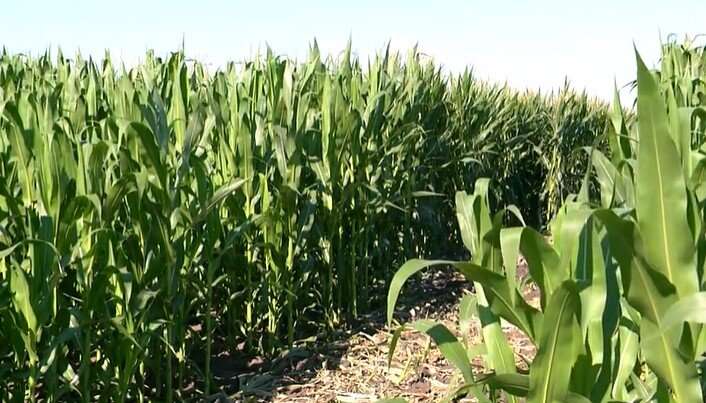Researchers studying leaf angle aim to improve yields, inspire young scientists

The angle of the leaves on a corn stalk directly affects the plant's ability to soak up the summer sun needed for photosynthesis.
Breeders have developed various corn hybrids with an upright leaf angle, as opposed to a flat leaf, to assist in the photosynthetic process and improve crop yields, particularly in densely planted fields. Still, the genetic mechanisms that control this trait are relatively unknown.
To better understand the underlying structure of leaf angle, an interdisciplinary research team, led by Iowa State University's Jianming Yu, is working to identify the genes using a robot developed at Iowa State to capture 3D images of corn in the field as well as transcriptomic- and CRISPR-based tools. The research has the potential to aid in the engineering of new hybrids and boost yields.
"Knowing the exact genes and genetic mechanisms will make the future of breeding more efficient," said Yu, a professor of agronomy and Pioneer Distinguished Chair in Maize Breeding. "Corn is a model crop and the information we gain can be leveraged by other crops, such as sorghum and millet, to improve their process."
In addition to improving yields—which helps limit land converted to crop production—Yu says scientists can use the genetic information to adapt future hybrids to changes in climate.
Deploying a robot in the field
Previous large-scale field studies have examined one or two selected corn leaves to study leaf angle. But since leaf angle can vary across the canopy of a corn field and along the stalk of a single plant, affecting the amount of light reaching each leaf, Yu and his colleagues are taking a different approach.
The research team will deploy a robot, called PhenoBot 3.0, to navigate the narrow rows of corn and capture 3D images of thousands of corn plants from different viewing angles and at multiple heights to automatically detect and measure leaf angles from the bottom to top of each plant. PhenoBot 3.0 (watch above video to see it in action) was developed by Lie Tang, a member of the research team and a professor of agricultural and biosystems engineering at Iowa State.
"Using an AI-driven image processing algorithm to automate leaf angle measurement, we can use the PhenoBot to efficiently collect and analyze the data from the field," Tang said. "Based on the results from preliminary studies, which we compared to measurements collected manually, the algorithm is very accurate."
Yu added, "With this enabling technology, we can better connect with DNA data to pinpoint genes and understand biology. That is where additional research in developmental genetics and CRISPR gene editing part of the research comes in."
Yu and Tang are faculty scholars with Iowa State's Plant Sciences Institute, which encourages collaborations among plant scientists, engineers and computational scientists to develop novel approaches and technologies for studying crop biology.
Inspiring future scientists
Yu says the interdisciplinary research team is a good example of how biologists, engineers and plant scientists can take a holistic approach to a problem and find a solution. To inspire interest in future scientists, the team will work with K-12 educators to plant school gardens and help students learn about plant biology, agriculture and crop improvement.
"We want to introduce students to the leaf angle research and show them how biologists, breeders or geneticists can improve the modern corn plant to help feed the world," Yu said.
Provided by Iowa State University




















